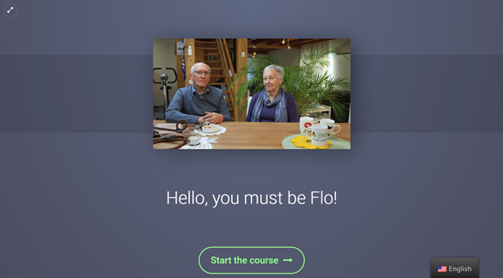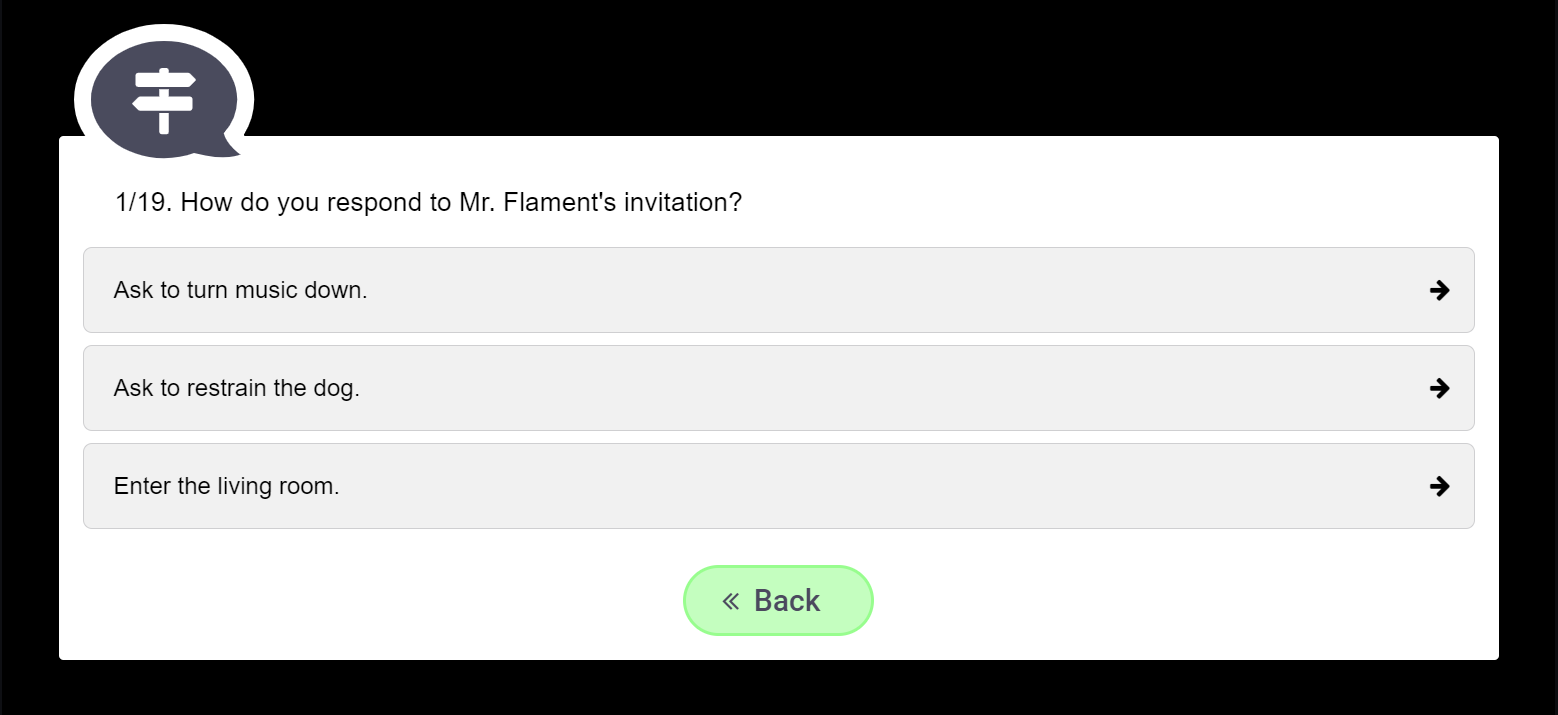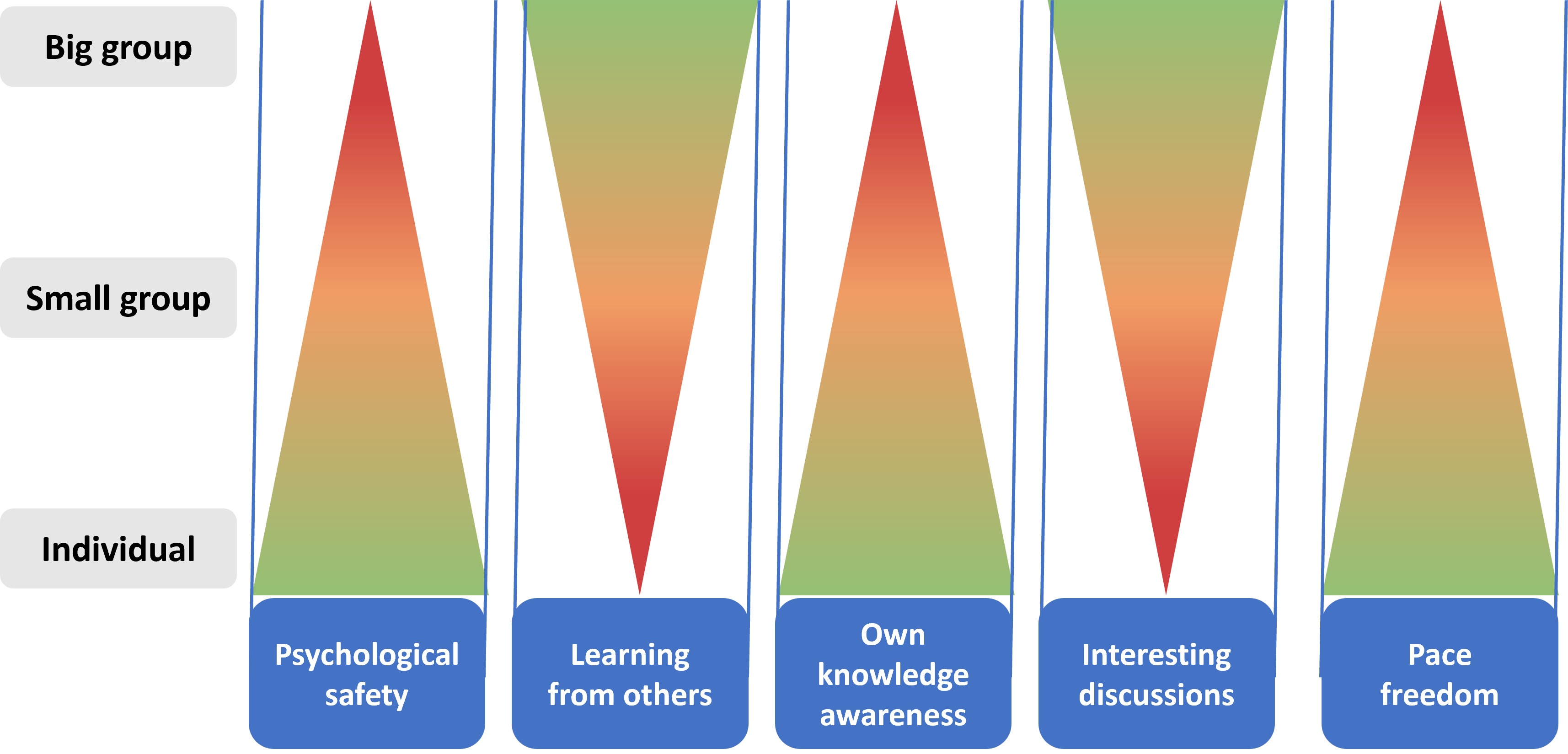11 Enactment
Enactment is the term used to name the time in which the learners will be immersed in the self-directed simulation process, taking the role of Flo, the health care practitioner who is going to make the home visit to Mrs. Nelly Flament.
This VGS is prepared to be played asynchronously and individually by students, and it provides all the instructions and resources needed for this purpose. This means that learners can access this simulation whenever they want and from wherever they want and take part in the whole experience with no need of intervention by any mentor or facilitator, only with a computer or tablet.
However, there are other ways in which the simulation can be implemented such us when played synchronously individually, in small groups, or in large groups of students (See green box below).
In our VGS students will be immersed in the role of Flo, and they will have to answer different questions that pop-up, as the situation unfolds.

Once the students click on the “Start the course” button, the video will start, and the students will have to make several decisions about how to conduct the situation that will correspond to the 19 questions that have to be answered. Usually, questions have three answer options from which learners must choose the best one, but there are also questions with 2 or 4 possible answers. In case a wrong answer is chosen, a video or text feedback will appear to the students showing why that is not the best option and the consequences that that choice could have. Finally, students will be redirected to the same question and they will have to answer it again. If the correct answer is chosen, the situation will continue.

 modalities of enactment: Advantages and disadvantages
modalities of enactment: Advantages and disadvantages
The fact that the simulation is played asynchronously and online by the users makes the application of the VGS more easy from the point of view of the facilitator as he or she just needs to ask their students to play the simulation in a limited frame of time. It can also be more beneficial in some points to the students, as they can devote the amount of time that they need to complete the simulation without any pressure of the group or the facilitator, the feeling of immersion will be stronger, they will experience a higher degree of psychological safety, with no risk of being judged by the option they pick in the decision points, and the self-awareness of their real knowledge about the topic will be more accurate as they have to face the situation on their own. Nonetheless, as established by Verkuyl et al. (2022), it also has some drawbacks such as the lack of support during the experience in terms of technology or content, making more difficult for the students to overcome unexpected issues that might arise while playing, or the lack of group support, not being able to exchange their impressions and perspectives with their co-learners as the situation unfolds, and the lack of learning from the doubts that might arise from other learners.
However, there are also other ways in which this VGS can be used in an educational context that will demand an active presence of the facilitator such as when played synchronously individually, in small groups, or in large groups of students.
 In the case of the individual synchronous way in the classroom, they will get most of the advantages previously described, but the possibility of playing it without time restrictions. However, they will also have the advantage of having technological, content and group support in case it is needed by the students.
In the case of the individual synchronous way in the classroom, they will get most of the advantages previously described, but the possibility of playing it without time restrictions. However, they will also have the advantage of having technological, content and group support in case it is needed by the students. Implementing the simulation with small groups, in our case, refers to groups up to 10 learners, while big groups will include 10 or more learners (Verkuyl et al., 2022). In the first case, one student could be in charge of managing the simulation for each group, while in the case of the big group, the teacher will be in charge of managing the simulation, thus the feeling of immersion will be much lower. In these cases the learners will lose some of the advantages described for the individual playing, but they will have more technological and content support by the facilitator. The learners will also be able to exchange opinions and perceptions, being able to generate rich discussions while playing, and they will have the chance to learn from the other’s questions. Nonetheless, in these cases, the individual awareness of one’s knowledge will be more diluted into the group and the time pace of the group will be preferent in front of the individual rhythm. Also some students might be embarrassed to share their thoughts because of their fear to be judged, what will turn into a fewer learning profit, especially in the large groups.
Implementing the simulation with small groups, in our case, refers to groups up to 10 learners, while big groups will include 10 or more learners (Verkuyl et al., 2022). In the first case, one student could be in charge of managing the simulation for each group, while in the case of the big group, the teacher will be in charge of managing the simulation, thus the feeling of immersion will be much lower. In these cases the learners will lose some of the advantages described for the individual playing, but they will have more technological and content support by the facilitator. The learners will also be able to exchange opinions and perceptions, being able to generate rich discussions while playing, and they will have the chance to learn from the other’s questions. Nonetheless, in these cases, the individual awareness of one’s knowledge will be more diluted into the group and the time pace of the group will be preferent in front of the individual rhythm. Also some students might be embarrassed to share their thoughts because of their fear to be judged, what will turn into a fewer learning profit, especially in the large groups.In addition to these advantages and disadvantages we also must take into consideration the perspective of the facilitator, whose role will be much more demanding in the case of the large group sessions.
In next figure we can see a summary of some of the main advantages and disadvantages based on the work of Verkuyl et al. (2022) and Verkuyl et al. (2019).

Based on the multiple ways of implementing the VGS, and the fact that all of them present positive and negative sides it is important that the facilitators explore and get familiar with the pros and cons of the different enactment modalities. In this way, they can decide which is the option that best aligns with the learning outcomes of their own specific activity, the features of their learners, and the available resources that they have. Therefore, facilitators can establish the appropriate guidelines in the prebriefing session in order to prepare students for the type of enactment that they are going to encounter (Hanna et al., 2022; Verkuyl et al., 2019).
These are some advices that might help facilitator in conducting a successful enactment of the VGS, in case a facilitated enactment is done:
- Allow the scenario to progress without interruptions.
- Behave in a calm, supportive, respectful, and non-judgmental manner, so that an atmosphere of trust can be created.
- Try to abate unethical or unprofessional behaviours if they appear during the simulation.
- Maintain confidentiality about the performances or dialogues and establish policies or procedures to share information with those who might have a legitimate educational or research interest.
- Collect assessment information through the observation of the students’ performance.
- Give clues to help participants to understand the virtual simulated case and conduct them towards the expected learning outcomes in case it is needed.
 complementary resources
complementary resources
We highly recommend checking the following resources to properly conduct the enactment phase of the VGS:
- INACSL Standards Committee, Persico, L., Belle, A., DiGregorio, H., Wilson-Keates, B., & Shelton, C. (2021, September). Healthcare Simulation Standards of Best PracticeTM Facilitation. Clinical Simulation in Nursing, 58, 22-26. https://doi.org/10.1016/j.ecns.2021.08.010
- INACSL Standards Committee (2016, December). INACSL standards of best practice: Simulation SM Professional integrity. Clinical Simulation in Nursing, 12(S), S30-S33. http://dx.doi.org/10.1016/j.ecns.2016.09.010


